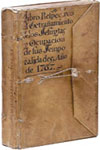Introduction a l'Analyse des Lignes Courbes Algébriques. CRAMER'S RULE AND PARADOX
CRAMER, Gabriel
Librería:
Landmarks of Science Books, Richmond, Reino Unido
Calificación del vendedor: 5 de 5 estrellas
![]()
Vendedor de AbeBooks desde 17 de marzo de 2016
Descripción
Descripción:
First edition of this major treatise on analytic geometry, containing 'Cramer's rule' and 'Cramer's paradox.' It was "the most complete exposition of algebraic curves existing at that time" (Struik), and "a worthy successor to Newton's Enumeratio" (Boyer). According to Cantor, this together with Euler's 'Introductio,' forms the first actual text-book on algebraic curves, and it "contains the earliest demonstration that a curve of the nth degree is in general determined if n(n+3)/2 points on it be given" (Ball). "Cramer's major publication 'Introduction à l'analyse lignes courbes algébriques,' was published in 1750. The first chapter . . . defines regular, irregular, transcendental, mechanical, and irrational curves and discusses some techniques of graphing, including our present convention for the positive directions on coordinate axes. The second chapter deals with transformations of curves, especially those which simplify their equations, and the third chapter develops a classification of algebraic curves by order or degree, abandoning Descartes's classification by genera. Both Cramer's rule and Cramer's paradox develop out of this chapter. The remaining ten chapters include discussions of the graphical solution of equations, diameters, branch points and singular points, tangents, points of inflection, maxima, minima, and curvature . . . He states that he has found a general and convenient rule for the solution of a set of n linear equations in n unknowns; but since this is algebra, he has put it into appendix 1 . . . The use of raised numerals as indices, not exponents, applied to coefficients represented by capital letters enabled Cramer to state his rule in general terms and to define the signs of the products in terms of the number of inversions of these indices when the factors are arranged in alphabetical order. Although Leibniz had suggested a method for solving systems of linear equations in a letter to L'Hospital in 1693, and centuries earlier the Chinese had used similar patterns in solving them, Cramer has been given priority in the publication of this rule . . . Cramer's paradox was the outgrowth of combining the formula n(n+3)/2 with the theorem, which Cramer attributes to Maclaurin, that mth- and nth- order curves intersect in mn points. The formula says, for example, that a cubic curve is uniquely determined by nine points; the theorem says that two different cubic curves would intersect in nine points" (DSB). Thus, although 3(3+3)/2 = 9 points 'in general' determine a cubic curve, these two diffreent cubic curves both pass through the same 9 points. The resolution of this paradox lies in the phrase 'in general'. Honeyman 775; DSB III, p.460; Struik, A Source Book in Mathematics 1200-1800, pp.180-81; Boyer, History of Analytic Geometry, pp.194-96; Ball, A Short Account of the History of Mathematics, pp. 371-72; Coolidge, History of Geometrical Methods, pp.132-33; Cajori, A History of Mathematics, p.241. 4to, pp. xxiii, [1, blank], 680, xi, [1, errata], with 33 folding engraved plates and one folding letterpress table (first few leaves foxed), a page of additional errata in a contemporary hand loosely inserted. Contemporary Continental mottled calf, spine richly gilt, lettered direct, marbled edges matching pastedowns and endleaves (a little rubbed). N° de ref. del artículo ABE-1586968977034
Detalles bibliográficos
Título: Introduction a l'Analyse des Lignes Courbes ...
Editorial: Geneva: Freres Cramer & Cl. Philbert
Año de publicación: 1750
Encuadernación: Hardcover
Condición: Very Good
Edición: 1st Edition
IberLibro.com es un mercado online donde puede comprar millones de libros antiguos, nuevos, usados, raros y agotados. Le ponemos en contacto con miles de librerías de todo el mundo. Comprar en IberLibro es fácil y 100% seguro. Busque un libro, realice el pedido a través de nuestra página con toda confianza y recíbalo directamente de la librería.
Busque entre millones de libros de miles de librerías
Libros usados
Bestsellers rebajados, autores destacados y una gran variedad de libros por menos de 5 €. Si su pasatiempo es leer, éste es su espacio.
Libros antiguos y de colección
Compendio vital para el amante del libro antiguo: libros firmados, primeras ediciones, facsímiles, librerías anticuarias o destacados.
Libros con envío gratis
Gastos de envío gratuitos para miles de libros nuevos, antiguos y de ocasión. Sin compra mínima.






